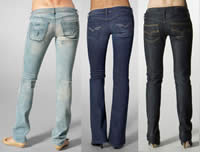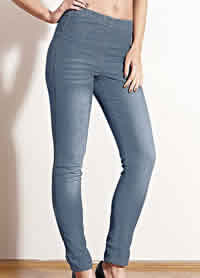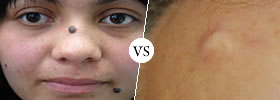Difference between Jeans and Jeggings
Key Difference: Jeans are trousers that are made from denim or dungaree cloth material. The fabric of jeans was initially hard and rough, however other materials such as cotton and latex, have been added to make it stretchable and comfortable. Jeggings are a mixed hybrid of jeans and leggings. There are two types of jeggings: jeggings which are made from legging material and denim jeans which have been combined with stretchable material to give it the elasticity of legging.
Styles continue to change depending on the newest trend to hit the market or the runway. Style, trend and fashion are never constant. The most recent trend to hit the market is jeggings, a combination of jeans and leggings. Though jeggings have been derived from jeans, they differ from jeans in a number of ways.
 Jeans are trousers that are made from denim or dungaree cloth material. Jeans were made popular by the blue denim trousers invented Levi Strauss in 1873. Denim material was invented in Nimes, France, from where it acquires its name de Nimes (from Nimes), or in short denims. Jeans were usually dyed with the most popular dye at that time, indigo, which gave its dark blue color. Jeans become a popular material during the gold rush in mid-1800s, when the miners required sturdy cloth that would not tear or damage easily. Strauss’ denim jean overalls made the perfect material for this type of work. Strauss and Jacob Davis are often credited for inventing the modern jeans. Strauss and Jacob initially patented the metal rivets on the pockets, to keep the pockets from ripping away from the rest of the fabric.
Jeans are trousers that are made from denim or dungaree cloth material. Jeans were made popular by the blue denim trousers invented Levi Strauss in 1873. Denim material was invented in Nimes, France, from where it acquires its name de Nimes (from Nimes), or in short denims. Jeans were usually dyed with the most popular dye at that time, indigo, which gave its dark blue color. Jeans become a popular material during the gold rush in mid-1800s, when the miners required sturdy cloth that would not tear or damage easily. Strauss’ denim jean overalls made the perfect material for this type of work. Strauss and Jacob Davis are often credited for inventing the modern jeans. Strauss and Jacob initially patented the metal rivets on the pockets, to keep the pockets from ripping away from the rest of the fabric.
Jeans become a fashion trend during the 1950s when cowboys were sported wearing jeans in western movies. During the same decade, movies such as Rebel Without a Cause, promoted the jeans to become a teenage rebel symbol. These jeans started gaining popularity as they were being banned from many colleges and schools. As jeans become popular, they started being made in different styles, colors, cut, etc. These days, jeans are available in various different colors (pink, blue, black, etc) and various different styles (high rise, low rise, boot cut, skinny, bell-bottoms, flare, wide, straight leg, etc). The fabric of jeans was initially hard and rough, however other materials such as cotton and latex, have been added to make it stretchable and comfortable.

Jeggings are a mixed hybrid of jeans and leggings. There are two types of jeggings: jeggings which are made from legging material and
denim jeans which have been combined with stretchable material to give it the elasticity of legging. Both of these are termed as jeggings. Jeggings gained popularity in the mid-to-late 2000s, promoted by skinny jeans style. The first type of jeggings includes leggings materials such as cotton, spandex, latex, etc and is dyed or painted in a way to make it look like jeans. This type of jeggings is most commonly supported by elastic waistband and does not include any pockets or has fake pockets.
The second type of jeggings is actually denim, which is weaved with cotton, latex or spandex in order to give it a elasticity to make it more comfortable for people with curves. This type hugs the body and curves to its shape. This type of jeans usually has a front fastening buttons or a zipper and also includes pockets. These are known as ‘denim jeggings’ and are more similar to skinny jeans compared to jeggings. Jeggings are considered to be more hugging compared to skinny jeans especially in the leg area, where they completely wrap around the ankles, while proper jeans would leave a little space. Jeggings are more commonly used by females and it yet remains to be seen if this trend will catch on with the male population.
Image Courtesy: stylistannalisa.blogspot.in, witt-international.co.uk









Add new comment